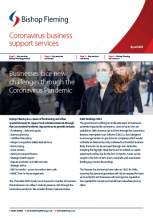Coronavirus: help for the self-employed
UPDATED TO REFLECT ANNOUNCEMENTS ON 5 NOVEMBER 2020
(PREVIOUS CHANGES - HMRC GUIDANCE ON 24 SEPTEMBER 2020, THE CHANCELLOR'S STATEMENT ON 29 MAY 2020 AND THE WINTER ECONOMY PLAN on 24 September 2020..)
The Self-Employed Income Scheme (SEISS) was launched to help the self-employed or those in a partnership with the financial effects of the Coronavirus lockdown. HMRC calculates the grant and then invites those eligible to make a claim.
Claims had to be in by 13 July 2020 for first grant.
The scheme initially consisted of only one grant payable in May, but a second grant is payable from August.
The first taxable grant was based on 80% of a self-employed person's average monthly profits over the last three years, capped at £2,500 per month. This reduced to 70% for the second grant payable in August.
- The first grant covered the period from 1 March 2020 to 31 May 2020 and was worth up to £7,500
- the second grant covers the period from 1 June 2020 to 31 August 2020 and is worth up to £6,570
- Applications for the second grant opened in August. Individuals are able to claim a second taxable grant worth 70% of their average monthly trading profits, paid out in a single instalment covering three months’ worth of profits, and capped at £6,570 in total.
- The eligibility criteria are the same for both grants, and individuals will need to confirm that their business has been adversely affected by coronavirus.
- An individual does not need to have claimed the first grant to receive the second grant: for example, they may only have been adversely affected by COVID-19 in this later phase.
- Further guidance on the second grant was published on 12 June.
Applications for the 2nd grant were open until 19 October.
The second grant up to 31 August was paid out in a lump sum that month, covering three months’ worth of average monthly profits. This grant will be 70% of average profits, up to a total £6,570
On 5 November 2020 the Chancellor announced there would be an extension to the scheme with two lump sum grants between November 2020 and April 2021. See our separate article on this.
Recipients of grants can continue to work or take on other employment, including voluntary work.
A claim cannot be made if the claimant is above the state aid limits or operates a trade through a trust.
Directors and employees paid through PAYE may qualify for the separate Job Retention Scheme, though new claims under that scheme can be made after 10 June 2020.
Military reservists returning from active duty
Self-employed military reservists who currently cannot access the SEISS as a direct result of their service in 2018-19 will be able to make a claim for both the first and second SEISS grants. Further information on how to do this will be published in due course by the government.
Self-employed new parents
Self-employed parents whose trading profits dipped in 2018/19 because they took time out to have children will be able to claim for a payment under the scheme.
Mothers, fathers and those who have adopted, who took time out of trading to care for their children within the first 12 months of birth of the child or within 12 months of an adoption placement, can use either their 2017-18 or both their 2016-17 and 2017-18 self-assessment returns as the basis for their eligibility for the SEISS.
Check if you may be eligible
You can use an online tool to find out if you’re eligible to make a claim. There is an option within the checker that allows you to challenge HMRC's decision where you disagree with the calculation.
If you are not eligible for some reason, there is other government support available such as the Bounce Back loans.
Details of the scheme
Self-employed individuals and members of a partnership will get the following support:
- Self employed Income support scheme - taxable grant of 80% of their average monthly profits over the last three years up to £2,500 per month (then 70% for the second tranche payable in August)
- Where there is less than three years of accounts, HMRC will look at what has been submitted.
- Where newly self-employed have not filed anything, they will need to access welfare benefits such as Universal Credit..
- It’s only open to those with average trading profits of up to £50,000 in tax years 2016/17 to 2018/19, who make 50% or more of their income from self-employment.
- To minimise fraud, only those already in self-employment, who have submitted a tax return for the year to 5 April 2019 can apply.
- Payments for the first grant are backdated to 1 March 2020
- To make sure no one who needs it misses out on support, the government did allow anyone who missed the tax return filing deadline in January 2020 until 23 April 2020 to submit it. However, there is a longer filing time (30 September 2020) where someone has loans covered by the loan charge (see further below).
- Where an amended return was submitted after 26 March 2020, any changes will not be taken into account when working out eligibility or amount of the grant.
- There is also available an advance payment of Universal Credit from the DWP for those self employed who need money before the grants flow through. There is further information below on Universal Credit.
- The Coronavirus Business Interruption Loan and Bounce Back loans are also available to the self-employed.
Further details are being added to the HMRC website.
In computing trading profits, HMRC will use the figures on tax returns for total trading income (turnover), then deduct any allowable business expenses and capital expenditure (including capital expenditure). Any losses carried forward from previous years will not be deducted from trading profits.
Example for the first grant
Gary has self-employed trading profits for the last three tax years, and has no other income. His business has been affected by the coronavirus:
- 2016/17 tax year £18,000
- 2017/18 tax year £24,000
- 2018/19 tax year £27,000
HMRC will invite Gary to make a claim via an online portal, and will compute his grant as £4,600 which will be paid directly into his bank account.
The grant was computed as £18,000 + £24,000 + £27,000 = £69,000, which averages at £23,000 per tax year.
Gary can receive from the government 80% of his average profits of £23,000 for three months, so £23,000 x 80% x 3/12, which is £4,600. This will be treated as taxable income.
How the Scheme Works
In addition to submitting your 2018/19 tax return, you must also have:
- traded in 2019/20;
- are trading at the point you can apply (unless Covid-19 prevents this);
- have lost trading/partnership trading profits due to Covid-19; and
- intend to trade in 2020/21.
The self-employed will have to get more than half of their income from self-employment and have a trading profit of less than £50,000 in 2018-19, or an average trading profit of less than £50,000 from 2016-17, 2017-18 and 2018-19.
If the business started trading between 2016 and 2019, HMRC will only consider those years in which a tax return has been submitted.
In a written answer to Parliament, the government says that it was not possible to include those who began trading after the 2018-19 tax year in the scheme, due to concerns about fraudulent claims.
HMRC will use data on 2018/19 tax returns to identify those eligible for the scheme, and will contact those eligible “once the scheme is operational”.
What this means is that payments are unlikely to be made before June, though will then effectively be three months' work of grant in one lump sum. In the meantime, those eligible will have to rely on savings, borrowings or benefits to cover the gap.
Where a claimant has loans covered by the loan charge
If you’re self-employed and have received payment for work or services in the form of a loan or other form of credit covered by the loan charge, you may be able to claim the grant, however your eligibility and average trading profits will be based on either:
- the average of the tax years 2016 to 2017 and 2017 to 2018
- the tax year 2017 to 2018, if you were not self-employed in the tax year 2016 to 2017
You do not have to file your 2018 to 2019 Self Assessment tax return by 23 April 2020, as the deadline for submission is extended to 30 September 2020.
Farmers’ averaging relief
Where a self-employed farmer is claiming farmers’ averaging relief HMRC will use the amount of profit before the impact of the averaging claims to work out:
- if the grant can be claimed
- how much grant to pay
Eligibility
Trading profits must be no more than £50,000 and more than half of your total income for either:
- the tax year 2018-2019
- the average of the tax years 2016-2017, 2017-2018, and 2018-2019
Example
| 2016/2017 | 2017/2018 | 2018/2019 | Average for 3 tax years | |
|---|---|---|---|---|
| Trading profit / (loss) | £50,000 | £50,000 | (£10,000) | £30,000 |
| Pension income | £15,000 | £15,000 | £15,000 | £15,000 |
| Total income | £65,000 | £65,000 | £5,000 | £45,000 |
| Trading profit are more than half of your total income | Yes | Yes | No | Yes |
So even if you made a loss in the tax year 2018 to 2019, you would still be eligible for the grant because your average trading profit for the 3 tax years:
- is £30,000 - which is less than £50,000
- is more than half of your total income of £45,000
Future tax and NIC parity between the employed and self-employed
The Chancellor has indicated that there would in future be a much closer parity between the National Insurance paid by employees and the self-employed, the details for which will follow in due course, probably in a future Budget.
So the 9% NICs for self-employed may be equalised with 12% paid by employees on the basis that they get the same treatment so should pay the same tax.
But the 2019 Conservative Party manifesto did promise that there would be no increase in NICs during this Parliament, so attempting to increase them for the self-employed could result in a re-run of 2017 when the then Chancellor Philip Hammond had to do a humiliating u-turn on increasing Class 4 NICs for the self-employed from 9% to 11%, as the manifesto had promised there would be no increase..
Personal service companies
Those who pay themselves a salary and dividends through their own company are not covered by the scheme, but may be covered for their salary only by the Coronavirus Job Retention Scheme if they are operating PAYE schemes. (Please see our separate article on this). However, they may have to prove that they have stopped working.
The duties of a director are taxed as an officeholder, not as an employee. Directors have to designate themselves separately as an employee of their own company, though there is conflicting case law on this. See our article on whether directors can furlough themselves.
Construction Industry Scheme
Where someone works in the construction industry and is dealt with under the Construction Industry Scheme, they are self-employed, even though they receive payslips. So provided returns have been submitted, they will qualify for the self-employed income support scheme.
Further reference
The House of Commons Library has published Further information about the self employed scheme.
Other help already offered to the self-employed
NOTE: As regards Universal Credit claims, on 26 May 2020 the Department for Work & Pensions confirmed that grants from the SEISS will be treated as income in the usual way, and that payments from the Coronavirus Job Retention Scheme to a self-employed person, to fund the pay of their employees’ will be ignored in the calculation of the Universal Credit award.
In addition to the above, the following has already been announced for the self employed:
- No interest on business interruption loans for the first twelve months.
- Up to £50,000 bounce back loans 100% backed by the government.
- Deferring the next quarter's VAT payment - No business will pay VAT from now to mid June. This is automatic. VAT returns still have to be submitted. You'll have until 31 March 2021 to repay those bills. Traders who normally pay by direct debit should cancel their DD with their bank if they are unable to pay. They need to do so in sufficient time so that HMRC do not attempt to automatically collect on receipt of your VAT return.
- Universal Credit and Working Tax Credit basic element enhanced for the next twelve months - increasing the Universal Credit standard allowance, for the next 12 months, by £1,000 a year. and increasing the Working Tax Credit basic element by the same amount.
- Self employed can now access Universal Credit with no floor limit - that means self-employed people can now access, in full, Universal Credit at a rate equivalent to Statutory Sick Pay for employees. Claiming universal credits may also unlock other benefits such as free school meals, a reduction in council tax and help with prescription costs and dental treatment.
- For the self-employed, (and anyone under self-assessment| the next self assessment payment due 31 July 2020 is deferred until January 2021. However, this could mean massive tax bills next January, so time to pay measures will be needed. Also, as profits may be impacted to 5 April 2021, payments on account in January 2021 could be reduced. See further commentary below.
- For renters, an extra £1bn of support by increasing the generosity of housing benefit and Universal Credit, so that the Local Housing Allowance will cover at least 30% of market rents in an area. There is a complete ban on evictions.
- Cash grants under the Small Business Grant Fund (SBGF) for businesses eligible for Small Business Rates Relief (SBRR) and Rural Rates Relief (RRR).
Taxation of the grants
The Finance Bill will include a clause to make the self-employed grants taxable.
Tax deferment
A word of warning about the deferment of self assessment tax until January 2021 as this could create large tax bills next year, although it is understood that there will be an easement on penalties and interest (to be confirmed by regulations).
There will be a time delay for the self employed before they see any actual reduction in their tax liability as income that falls into the tax year to 5 April 2021 is reported and tax paid in January/July 2022.
Where an accounting year/period ends early in the tax year, that will move to 2023. So there is a long term cash flow issue that will need to be addressed.
The first payment on account for 2020/2021 is 31 January 2021, when submitting your return for 2019/2020. The second payment on account will be on 31 July 2021.
What a self employed person will need to do is apply for reduced payments on account for the tax year 2020/ 2021 in the tax return sent in by 31 January 2021.
HMRC helpline
HMRC has issued guidance on deferring tax payments that are due on 31 July 2020.
Any self--employed individual concerned about paying their tax due to coronavirus, can call HMRC’s helpline for help and advice: 0800 024 1222.
NOTE that as part of the Winter Economy Plan, the Chancellor announced that tax deferments can be repaid over a twelve-month period.
Further updates
The Treasury has issued a Directive on how the scheme will work in place of legislation.
The House of Commons Library has published a detailed report on the scheme.
Low Incomes Tax Reform Group - common problems with the scheme.
For the latest, check out the Coronavirus KnowldegeHub.
[Gary Mackley-Smith]






